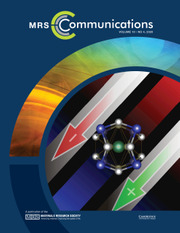Article contents
One-step fabrication of binder-free three-dimensional Co3O4 electrodes by Reactive Spray Deposition Technology for application in high-performance supercapacitors
Published online by Cambridge University Press: 22 April 2018
Abstract

Binder-free three-dimensional Co3O4 electrodes are fabricated by an economical and scalable one-step flame combustion method, namely Reactive Spray Deposition Technology. The electrodes are composed of porous nanostructured Co3O4 uniformly distributed throughout the conductive substrate. In the absence of any further optimization on the processing conditions, the as-synthesized electrodes demonstrate high capacitance of 567 F g−1 at 1.5 A g−1, excellent rate capability, and stable cycling performance with a capacity retention ratio of 96.7% after 1000 charge/discharge cycles from the three-electrode half-cell testing. This study presents the pathway to a significantly simplified manufacturing process of three-dimensional electrodes with the desirable porous nanostructure.
Information
- Type
- Research Letters
- Information
- Copyright
- Copyright © Materials Research Society 2018
References
- 6
- Cited by


